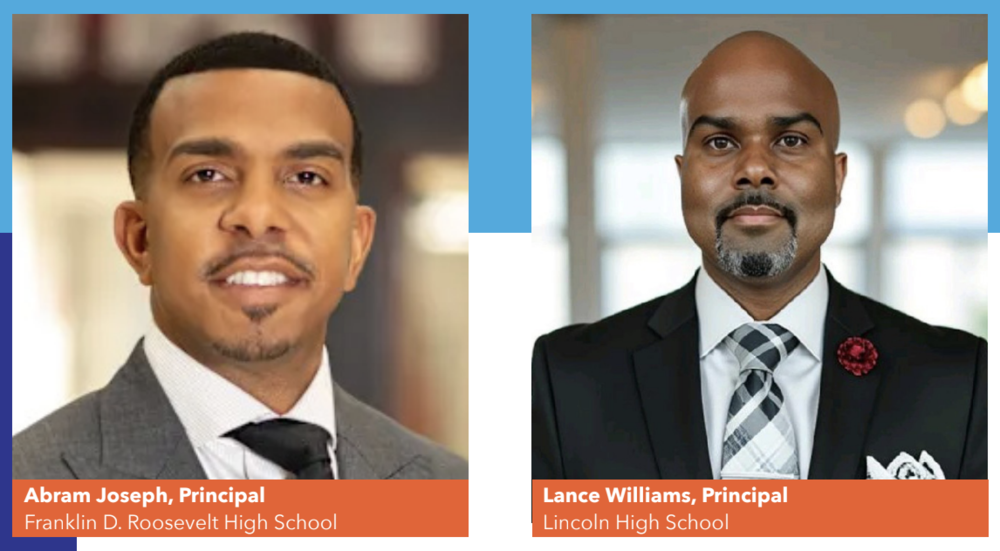In the heart of Dallas, two historic high schools are experiencing remarkable transformations. At Roosevelt and Lincoln, principals Abram Joseph and Lance Williams are proving that with the right leadership, systems, and unwavering belief in students and staff, even the most challenging turnarounds are possible.
When Abram Joseph arrived at Roosevelt High School, he walked into a building with a powerful legacy but a complex current reality. The school’s most recent state report card showed all F’s across the board. Six principals had cycled through in twelve years. Yet Joseph, in what he now calls divine protection, didn’t do extensive research before accepting the role.
“God just covered me,” Joseph reflects. “I didn’t even lean in to try to find out, hey, is it good? Is it bad? I just knew this was my passion, my purpose, my calling.”
That calling led him to a school with deep roots in Dallas’s Black community. Roosevelt was the first new high school in Dallas ISD built specifically for non-white students since 1939. Generations of Roosevelt Mustangs identify themselves by their graduation year, a tradition Joseph had never seen at other schools.
Meanwhile, across the Trinity River at Lincoln High School, Lance Williams faced different challenges. Lincoln High School was created as an overflow campus for Booker T. Washington, the only school that served the Black community at the time. It carried its own legacy of excellence, including politicians, judges, athletes, and other people of prominence. But when Williams arrived, he found a “spirit of uncertainty” among staff.
When Williams gathered his leadership team and asked them to articulate the school’s vision, silence filled the room. Together, they created a new vision: to champion an educational experience that prepares scholars to lead the way in a dynamic and global society.
Different Styles, Shared Success
The two principals often joke about their contrasting approaches. Joseph calls himself Martin to Williams’s Malcolm, a reference to the civil rights leaders who pursued the same goal through different methods.
“Lance can be very direct. But he is brilliant. People know that. They’re receptive and people march to that,” Joseph says. “I think I internalize more before I determine how I will attack.”
Both men speak to each other three or four times a week, sharing practices and offering different perspectives that sharpen each other’s leadership. “I feel that’s the way it should be across any school community. That’s been my experience in Dallas ISD. We work together, Williams shared.
Operations Before Instruction
Both principals share a stance: school-wide culture and routines must come before instruction. “You have to have a clear set of procedures, systems, and a way to monitor and increase your efficacy in your operations in order for you to have a firm enough foundation to create that excellence on an instructional level,” Williams explains.
At Roosevelt, administrators conduct “temperature checks” every class period, standing in hallways in designated “V stances,” monitoring both instruction and student well-being. They practice every procedure before implementation. They never perform surgery on the day of surgery, as Joseph puts it.
At Lincoln, Williams implemented the power meeting cycle with precision. Data walls in classrooms create healthy competition between class periods. The administrative team huddles thirty minutes before students arrive each day to calibrate and strategize.
The Role of Region 10
Both principals worked with Region 10 consultant, Misty Chesnut, and found the partnership transformative. Joseph describes the relationship as a mirror, a reflective thought partner who collaborated rather than imposed, who understood what Roosevelt needed and customized her support accordingly.
Williams added, “My experience working with Region 10 has been one of trust. It has given me the opportunity to take our good practices and make them great.”
Williams appreciates how naturally the Effective Schools Framework connects with the Bambrick protocols he already uses. “It is like a beautiful marriage,” he said.
Both men emphasize that the success of the partnership depended on their willingness to receive feedback. “Most times when we receive a service, that service is either successful or unsuccessful because the person that’s receiving,” Joseph reflects. “You have to evaluate yourself and be ready to receive.”
Results That Speak
The numbers tell a compelling story of transformation. In just two years, both schools rose from the bottom 5% in the state to become model campuses for Texas Instructional Leadership.
Roosevelt jumped from all F’s to a C in year one, then soared to an 81 in year two. This was a 25-point gain achieved with the same staff. Lincoln saw a 12-point increase in overall state accountability rating in the first year, with CCMR jumping from 65 to 95 and graduation rates climbing from 86% to 92%. In year two, Lincoln jumped to an 81 and earned three distinctions: Achievement in Math, Achievement in Social Studies, and Top 25% Comparative Closing the Gaps.
Both schools are now consistently performing at B-level ratings and targeting A ratings for the current year.
Beyond Test Scores
For both principals, the work transcends accountability ratings. Joseph envisions Roosevelt students becoming Rhodes Scholars, business owners, physicists, and pastors, whatever allows them to reach their potential.
“I’m always going to check on your family. I’m going to always worry about your well-being,” Joseph says. “That’s more important to me than anything.”
Williams built core values into Lincoln’s culture: growth mindset, trust, and transparency. “You create trust over time, and you also create it with consistency in your actions.”
Advice for Other Leaders
“You weren’t called because you were qualified. You are qualified because you were called,” Williams says. “Transformation is a word that we throw around a lot, but it’s just a fancy word that means change. And change is dirty.”
Joseph’s advice emphasizes persistence: “Pray, keep your head down and continue to work. Brick by brick, I’m telling you, things can change. This is passion work. You could not have gotten this job if it wasn’t a calling.”
Despite any offers that might come their way, Joseph is clear about his commitment: “They could offer me a job anywhere as a high school principal, and I would respectfully decline. Right here at Roosevelt is where I want to be.”
Both men represent a new generation of school leadership in Dallas ISD. They are leaders who understand that turnaround work requires equal parts systems, humanity, and unwavering belief in what’s possible.
In South Dallas, two historic schools are being transformed not through magic or massive resources, but through dedicated leadership that builds excellence brick by brick, with systems that work, staff who are empowered, and an unwavering belief that every student deserves to reach their potential.
The Roosevelt Mustangs and Lincoln Tigers are living their legacy again.

